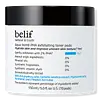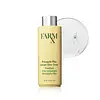What's inside
What's inside
 Key Ingredients
Key Ingredients

 Benefits
Benefits

 Concerns
Concerns

 Ingredients Side-by-side
Ingredients Side-by-side

Water
Skin ConditioningGlycerin
HumectantButylene Glycol
HumectantDipropylene Glycol
Humectant1,2-Hexanediol
Skin ConditioningGluconolactone
Skin ConditioningArginine
MaskingPanthenol
Skin ConditioningAllantoin
Skin ConditioningPolyglyceryl-10 Stearate
Skin ConditioningEthylhexylglycerin
Skin ConditioningPolyglyceryl-10 Oleate
Skin ConditioningCitric Acid
BufferingInonotus Obliquus Extract
Skin ConditioningSodium Hyaluronate
HumectantScutellaria Baicalensis Root Extract
AstringentCentella Asiatica Leaf Extract
Skin ConditioningAvena Sativa Kernel Extract
AbrasiveCalendula Officinalis Flower Extract
MaskingNepeta Cataria Extract
TonicRubus Idaeus Leaf Extract
Skin ConditioningBaptisia Tinctoria Root Extract
Skin ConditioningStellaria Media Extract
Skin ConditioningAlchemilla Vulgaris Leaf Extract
AntioxidantEquisetum Arvense Leaf Extract
AstringentUrtica Dioica Leaf Extract
Skin ConditioningBakuchiol
AntimicrobialBeta-Glucan
Skin ConditioningCorchorus Olitorius Leaf Extract
Skin ConditioningHamamelis Virginiana Extract
AntiseborrhoeicJasminum Officinale Extract
MaskingCitrus Aurantium Dulcis Peel Oil
MaskingCitrus Aurantifolia Oil
CleansingRosmarinus Officinalis Leaf Oil
MaskingPelargonium Graveolens Flower Oil
MaskingLimonene
PerfumingCitronellol
PerfumingGeraniol
PerfumingCitral
PerfumingWater, Glycerin, Butylene Glycol, Dipropylene Glycol, 1,2-Hexanediol, Gluconolactone, Arginine, Panthenol, Allantoin, Polyglyceryl-10 Stearate, Ethylhexylglycerin, Polyglyceryl-10 Oleate, Citric Acid, Inonotus Obliquus Extract, Sodium Hyaluronate, Scutellaria Baicalensis Root Extract, Centella Asiatica Leaf Extract, Avena Sativa Kernel Extract, Calendula Officinalis Flower Extract, Nepeta Cataria Extract, Rubus Idaeus Leaf Extract, Baptisia Tinctoria Root Extract, Stellaria Media Extract, Alchemilla Vulgaris Leaf Extract, Equisetum Arvense Leaf Extract, Urtica Dioica Leaf Extract, Bakuchiol, Beta-Glucan, Corchorus Olitorius Leaf Extract, Hamamelis Virginiana Extract, Jasminum Officinale Extract, Citrus Aurantium Dulcis Peel Oil, Citrus Aurantifolia Oil, Rosmarinus Officinalis Leaf Oil, Pelargonium Graveolens Flower Oil, Limonene, Citronellol, Geraniol, Citral
Water
Skin ConditioningPropanediol
SolventPentylene Glycol
Skin ConditioningGlycerin
HumectantEthoxydiglycol
HumectantPropylene Glycol
HumectantButylene Glycol
HumectantGlyceryl Caprylate
EmollientHydroxyethylcellulose
Emulsion StabilisingAllantoin
Skin ConditioningGluconolactone
Skin Conditioning1,2-Hexanediol
Skin ConditioningLactobacillus/Soybean Ferment Extract
Skin ConditioningSaccharomyces/Potato Extract Ferment Filtrate
HumectantSaccharomyces/Barley Seed Ferment Filtrate
HumectantPolyglyceryl-10 Stearate
Skin ConditioningPolyglyceryl-10 Oleate
Skin ConditioningArginine
MaskingSodium Hyaluronate
HumectantBeta-Glucan
Skin ConditioningAnanas Sativus Fruit Extract
Skin ConditioningHydrolyzed Corn Starch
HumectantCitrus Limon Peel Oil
MaskingSucrose
HumectantLactobacillus/Punica Granatum Fruit Ferment Extract
Skin ConditioningCarica Papaya Fruit Extract
Skin ConditioningCitrullus Lanatus Fruit Extract
Skin ConditioningCitrus Limon Peel Extract
EmollientSolanum Lycopersicum Fruit Extract
AntioxidantDisodium Phosphate
BufferingSodium Phosphate
BufferingPiper Nigrum Fruit Oil
MaskingZingiber Officinale Root Oil
MaskingCinnamomum Cassia Leaf Oil
MaskingRosa Damascena Flower Oil
MaskingAchillea Millefolium Extract
CleansingCalendula Officinalis Flower Extract
MaskingLavandula Angustifolia Flower/Leaf/Stem Extract
MaskingSalvia Officinalis Extract
AntimicrobialWater, Propanediol, Pentylene Glycol, Glycerin, Ethoxydiglycol, Propylene Glycol, Butylene Glycol, Glyceryl Caprylate, Hydroxyethylcellulose, Allantoin, Gluconolactone, 1,2-Hexanediol, Lactobacillus/Soybean Ferment Extract, Saccharomyces/Potato Extract Ferment Filtrate, Saccharomyces/Barley Seed Ferment Filtrate, Polyglyceryl-10 Stearate, Polyglyceryl-10 Oleate, Arginine, Sodium Hyaluronate, Beta-Glucan, Ananas Sativus Fruit Extract, Hydrolyzed Corn Starch, Citrus Limon Peel Oil, Sucrose, Lactobacillus/Punica Granatum Fruit Ferment Extract, Carica Papaya Fruit Extract, Citrullus Lanatus Fruit Extract, Citrus Limon Peel Extract, Solanum Lycopersicum Fruit Extract, Disodium Phosphate, Sodium Phosphate, Piper Nigrum Fruit Oil, Zingiber Officinale Root Oil, Cinnamomum Cassia Leaf Oil, Rosa Damascena Flower Oil, Achillea Millefolium Extract, Calendula Officinalis Flower Extract, Lavandula Angustifolia Flower/Leaf/Stem Extract, Salvia Officinalis Extract
Ingredients Explained
These ingredients are found in both products.
Ingredients higher up in an ingredient list are typically present in a larger amount.
1,2-Hexanediol is a synthetic liquid and another multi-functional powerhouse.
It is a:
- Humectant, drawing moisture into the skin
- Emollient, helping to soften skin
- Solvent, dispersing and stabilizing formulas
- Preservative booster, enhancing the antimicrobial activity of other preservatives
Allantoin is a soothing ingredient known for its protective and moisturizingg properties. Because of this, it is often added to products with strong active ingredients.
Studies show higher concentrations of this ingredient can promote wound healing.
Though it can be derived from the comfrey plant, allantoin is produced synthetically for cosmetic products to ensure purity.
Learn more about AllantoinArginine is an amino acid that is important for human development. Your body uses is it to produce hair keratin and skin collagen.
As a cosmetic ingredient, Arginine has antioxidant properties and can also help repair damaged skin. This ingredient is derived either synthetically or from animals.
Arginine isn't fungal acne safe when used in the presence of other lipids (fats, fatty acids, oils, esters, etc). Oils and fats occur naturally within the skin, so take caution when using Arginine if you're prone to fungal acne.
Learn more about ArginineBeta-Glucan is a polysaccharide. It can be derived from the cell walls of seaweed, oats, yeast, and fungi. It hydrates the skin and helps boost your skin's natural barrier.
As an antioxidant, beta-glucan helps fight free-radicals. Free-radicals are molecules that may damage your skin cells, such as pollution.
Studies show this ingredient may be an effective wrinkle reducer as it can deeply penetrate into skin. It has also been show to help with wound healing.
Learn more about Beta-GlucanButylene Glycol (or BG) is used within cosmetic products for a few different reasons:
Overall, Butylene Glycol is a safe and well-rounded ingredient that works well with other ingredients.
Though this ingredient works well with most skin types, some people with sensitive skin may experience a reaction such as allergic rashes, closed comedones, or itchiness.
Learn more about Butylene GlycolCalendula Officinalis Flower Extract comes from the common Marigold plant. This ingredient is a skin conditioner.
Marigolds contain flavonoids. Flavonoids are a group of substances found naturally in plants. They possess antioxidant and inflammation properties.
This ingredient soothes skin inflammation by inhibiting inhibiting a part of the inflammation process.
Marigolds have been used in traditional medicine throughout Asia and Europe.
Learn more about Calendula Officinalis Flower ExtractGluconolactone is a PHA. PHAs are a great gentle alternative to traditional AHAs.
When applied, Gluconolactone has the same affect on skin as AHAs such as lactic acid. It helps dissolve the dead skin cells in the top layer of your skin. This improves texture and brightens the skin.
PHAs are more gentle than AHAs due to their larger structure. They do not penetrate as deeply as AHAs and take a longer time to dissolve dead cells. Studies show PHAs do not cause as much irritation.
Gluconolactone has some interesting properties:
In a 2004 study, Gluconolactone was found to prevent UV damage in mouse skin cells and has not been found to increase sun sensitivity. However, we still recommend wearing SPF daily.
This ingredient is is an created by reacting gluconic acid with an alcohol.
Learn more about GluconolactoneGlycerin is already naturally found in your skin. It helps moisturize and protect your skin.
A study from 2016 found glycerin to be more effective as a humectant than AHAs and hyaluronic acid.
As a humectant, it helps the skin stay hydrated by pulling moisture to your skin. The low molecular weight of glycerin allows it to pull moisture into the deeper layers of your skin.
Hydrated skin improves your skin barrier; Your skin barrier helps protect against irritants and bacteria.
Glycerin has also been found to have antimicrobial and antiviral properties. Due to these properties, glycerin is often used in wound and burn treatments.
In cosmetics, glycerin is usually derived from plants such as soybean or palm. However, it can also be sourced from animals, such as tallow or animal fat.
This ingredient is organic, colorless, odorless, and non-toxic.
Glycerin is the name for this ingredient in American English. British English uses Glycerol/Glycerine.
Learn more about GlycerinPolyglyceryl-10 Oleate isn't fungal acne safe.
Polyglyceryl-10 Stearate is a skin conditioner with emollient and emulsifier properties.
It is an esther of stearic acid and Polyglycerin-10.
This ingredient may not be Malassezia folliculitis, or fungal-acne safe.
Learn more about Polyglyceryl-10 StearateSodium Hyaluronate is hyaluronic acid's salt form. It is commonly derived from the sodium salt of hyaluronic acid.
Like hyaluronic acid, it is great at holding water and acts as a humectant. This makes it a great skin hydrating ingredient.
Sodium Hyaluronate is naturally occurring in our bodies and is mostly found in eye fluid and joints.
These are some other common types of Hyaluronic Acid:
Learn more about Sodium HyaluronateWater. It's the most common cosmetic ingredient of all. You'll usually see it at the top of ingredient lists, meaning that it makes up the largest part of the product.
So why is it so popular? Water most often acts as a solvent - this means that it helps dissolve other ingredients into the formulation.
You'll also recognize water as that liquid we all need to stay alive. If you see this, drink a glass of water. Stay hydrated!
Learn more about Water